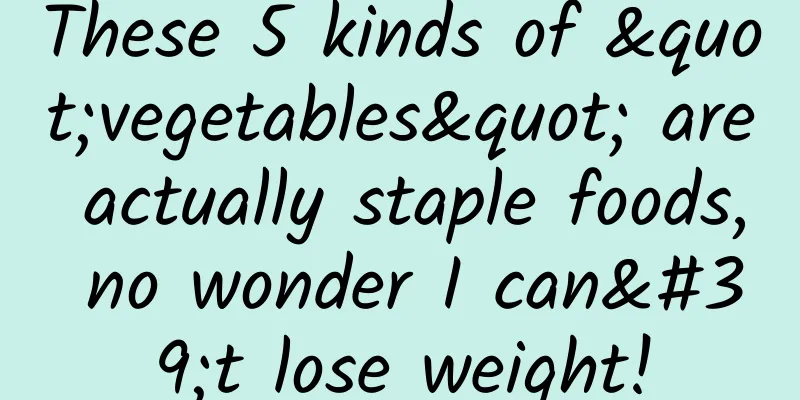These 5 kinds of "vegetables" are actually staple foods, no wonder I can't lose weight!

|
Friends who are losing weight are always worried that they will gain weight if they eat too much staple food . Limiting the intake of staple food has become a routine operation, but they often eat staple food that they think is vegetables without realizing it. Eating it once is not terrible, but what is terrible is that you have been fat for many years without knowing that "it" may actually be a staple food! ▲Photo: Photo Network Even if you want to lose weight, it is recommended that you eat an appropriate amount of staple food every day. However, there are 5 kinds of food that you must pay more attention to. Because they have a high carbohydrate content and higher energy than ordinary vegetables , they are often eaten as vegetables. No wonder you can't lose weight! This article will show you how these foods compare to rice, so that you can know what to eat. We will compare the data based on eating 100 grams of these foods or 50 grams of rice per meal. 50 grams of rice is about 100-130 grams of cooked rice. 1. Potatoes ▲Photo: Photo Network Many people think of potatoes as vegetables, and think that a plate of fried potatoes with rice is delicious. But you are wrong! Shredded potatoes + rice = staple food + staple food Potatoes, also known as potatoes, belong to the potato food. Cereal and potato food can be eaten as a staple food. Its carbohydrate content is not low, at 17.8 grams per 100 grams, which is 5 times higher than the common vegetables we often eat, such as Chinese cabbage, and the calories are nearly 4 times higher. It can completely replace part of the staple food. Moreover, potatoes are richer in dietary fiber than rice, which can enhance satiety, control food intake, and is more beneficial for weight loss. Potatoes are also richer in potassium and magnesium, which are also helpful in controlling blood pressure. 2. Yam ▲Photo: Photo Network Yam is also often regarded as a vegetable. Common dishes include yam stewed with pork ribs, yam fried with pork slices, yam fried with fungus, and blueberry yam. The carbohydrate content of different varieties of yam varies greatly, ranging from 11.6% to 29.2%, with an average of 18.7%. The starch content of Xishi seeds, Jipi rough, Tiegun yam, and Huai yam is not low. If you eat rice and eat fried yam crazily, you may gain weight! The potassium content of yam is also good, and eating it regularly is beneficial for controlling blood pressure. 3. Edamame ▲Photo: Photo Network Edamame is not only considered a vegetable by many people, but is also sometimes considered a snack. It is even more "exciting" to make a side dish for drinking. Not only is it very convenient to eat, but it is also... really delicious! The carbohydrate content of edamame is 10.5g/100g, but the calorie content is not low, almost catching up with 50g of rice. If you like to eat it, eat less staple food. It is worth mentioning that edamame is very good in protein, dietary fiber, potassium and magnesium content, and is excellent in enhancing satiety, promoting gastrointestinal motility, controlling blood pressure, and improving immunity. 4. Lotus root ▲Photo: Photo Network The taste of lotus roots varies depending on the variety. Some lotus roots taste crispy and are often used for stir-frying or cold salad; some lotus roots taste very soft and glutinous, and are used to make lotus root powder and osmanthus glutinous rice lotus root. The carbohydrate content of lotus root is 11.5g/100g, which is lower than that of potatoes, but higher than common vegetables, 1.4 times that of carrots, nearly 3 times that of white radish, and 3.4 times that of Chinese cabbage. The calories are also higher than them. Therefore, if there is lotus root in the dish, try to eat less of the staple food. 5. Pumpkin ▲Photo: Photo Network It depends on the variety of pumpkin. Not all pumpkins can replace staple foods. Some pumpkins are vegetable pumpkins and have a very low carbohydrate content. Some of the common Chinese pumpkins that have a juicy taste are pumpkins that can be used as vegetables. They have a carbohydrate content of only 5.3 grams per 100 grams and a water content of up to 93.5%. The pumpkin with low water content tastes very soft and has a higher carbohydrate content . For example, the carbohydrate content of Japanese pumpkin is 10.9 grams/100 grams, and the carbohydrate content of Indian pumpkin is as high as 20.6 grams/100 grams. The baby pumpkin and chestnut pumpkin that we often eat are both Indian pumpkins. Relatively speaking, they are more suitable to replace part of the staple food. Summarize: If you have the above 5 kinds of "vegetables" on the table, be careful not to treat them as vegetables and eat them with rice. References: [1] Yang Yuexin. Chinese Food Composition Table 6th Edition Volume 1[M]. Peking University Medical Press, 2018 [2] Japanese food composition table [3] Shu Rui, Li Xiaolong, Nie Yujie, et al. Comparative analysis of the main nutritional components of different varieties of yam [J]. Seed Science and Technology, 2019, 37(13): 33-34. |
<<: I heard that the word "evolution" can no longer be used?
>>: If you miss this step when using air conditioning in the summer, it’s really easy to get sick!
Recommend
Xiaokele mobile phone review: a thousand-yuan camera magic tool (hardware imaging)
In terms of appearance and system design, the styl...
Several tips to improve Android ListView performance
Translator’s Note: 1. Since this is a technical a...
What is the difference between n95 and kn95 masks? Which one is better?
Recently, there has been a new situation with Wuh...
What kind of insect is the "katydid" in "The Book of Songs"?
Produced by: Science Popularization China Author:...
A complete list of big data ASO optimization tools, which one do you think is the best?
What is ASO ? ASO is the abbreviation of " A...
3 key points to quickly increase followers on Xiaohongshu, recommended to save them!
In the past few days, I have looked at no less th...
Is it feasible to promote traffic on Douban? How to promote and attract traffic?
For those who are engaged in online promotion and...
The African guy's arms are tanned. How can he effectively avoid the scorching sun this year?
This summer is the hottest in history, which has ...
Which self-media platform is the best? 2018 self-media platform recommendation
In the past 2017, the self-media industry has ach...
Why do we need motion design?
With the rise of international brands such as App...
“Street stall economy” brand leverages marketing and copywriting!
The way people greet each other these days has ch...
What else can you do on the Spring Equinox besides "standing an egg"? Let's do the Eratosthenes experiment to estimate the circumference of the Earth!
Open any modern introductory science book or sear...
There is no public domain traffic in the world
2020 is also known as the "first year of the...









